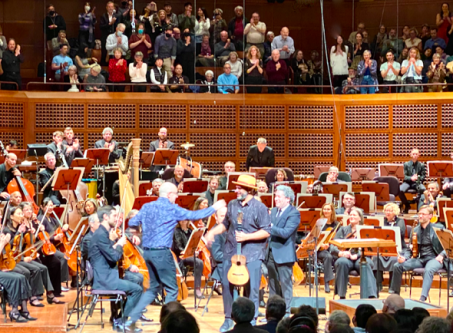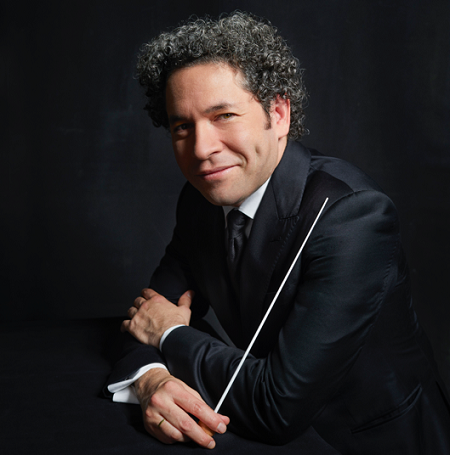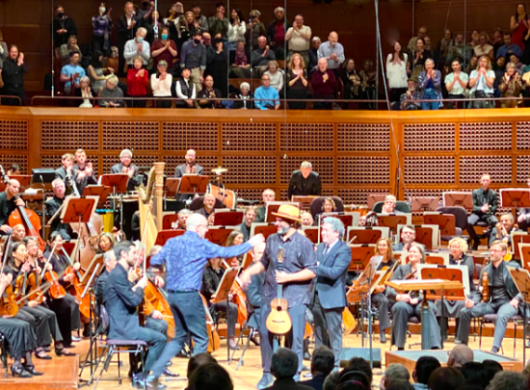 United States Ortiz, Grau, Brahms: Jorge Glem (cuatro), San Francisco Symphony / Gustavo Dudamel (conductor). Davies Symphony Hall, San Francisco, 25.11.2023. (HS)
United States Ortiz, Grau, Brahms: Jorge Glem (cuatro), San Francisco Symphony / Gustavo Dudamel (conductor). Davies Symphony Hall, San Francisco, 25.11.2023. (HS)

Gabriela Ortiz – ‘Kauyumari’
Gonzalo Grau – Odisea: Concerto for Venezuelan Cuatro and Orchestra
Brahms– Symphony No.2
The cuatro, a sort of pint-sized Venezuelan guitar that could be mistaken for a ukulele, hardly seems like an instrument to feature in a concerto. And yet, in the hands of a musical wizard like Jorge Glem, his fellow Venezuelan, composer Gonzalo Grau, and the Venezuela-born conductor Gustavo Dudamel, the music emerged as a 25-minute thrill ride. In the Davies Symphony Hall they generated enough electricity and depth to prove that Odisea really did deserve to be on the same San Francisco Symphony program as Brahms’s Symphony No.2.
This seems to be part of a trend. Recent concerts that I have attended, both here and elsewhere, spanned a wide range of music. They are not alone in identifying and presenting diverse and exciting works. Gratifyingly, these are more than obligatory efforts to be inclusive. What I have encountered recently in opera houses and concert halls, traditionally locations for tried-and-true classics, has been particularly juicy, especially in music created in the past ten years.
The son of a singer and composer, Grau trained in classical music and expanded into jazz and salsa as performer and producer. He was commissioned by the Los Angeles Philharmonic to write the piece, which premiered earlier this year under Dudamel with the L.A Philharmonic, where he is music director. The one-movement concerto traces a journey across Venezuela, dipping into the musical styles of several regions to create a sort of odyssey for the country’s national instrument.

Turns out that we don’t have to be familiar with these styles to enjoy the differences between the relaxed rhythms of coastal Venezuela and the lively intensity of the mountain songs, and all the stops in between. Glem’s virtuosity might have been enough, as he coaxed out broadly strummed harmonies, soulful melodies and an array of rhythms by various methods of striking the instrument’s wooden body. He produced a different range of colors and tone in each segment of the single-movement concerto.
Grau’s music brims with evocative gestures for the cuatro, and frames it with inventive voicings and classical-based utterings from the orchestra. Somehow, they never overwhelmed the soloist. Even the seven percussionists and a timpanist, used continually, were carefully held in check. They seasoned, rather than overwhelmed.
As an encore, Glem offered a dazzling improvisation that interpolated familiar melodies, including the ‘Ode to Joy’, snippets of Carmina Burana, the Venezuelan national anthem and folk tunes. It seemed to show off everything possible from this seemingly simple instrument, and that was a lot.
Dudamel opened the program with a six-minute tone poem by Mexican-born composer Gabriela Ortiz. ‘Kauyumari’ refers to a blue deer, said to be seen in peyote quests. The music gradually came into focus, then blossomed into vivid colors as a Mexican folk melody gained more complexity. It created a delightful effect.
After the intermission, Dudamel shaped an especially vital performance of the Brahms symphony. He found unhurried tempos that never dragged, and careful phrasing let the music bloom tellingly. There was a virility to this distinctive interpretation that allowed for a seductive sway to the dancelike second theme in the opening movement. The music came alive with subtle details to dynamics and ever-so-slight ritards and accelerandos.
Especially welcome was the balance between shadow and light in the Adagio. Dudamel never let things loll, but made the music float almost weightlessly, even as it became busier before receding into a sigh. The wistful third movement felt dreamy, before the finale amped things up decisively. The vitality and punch of decisive rhythms supplanted the holding-back of the first three movements, and the music seemed to jump from the stage.
I am not quite sure why Dudamel had the second violins leap to their feet for their few measures before the finish, but it was startling to see and somehow seemed to fit a sense of revelry that underlay the interpretation. A long and effective buildup to that finish had gradually muscled things up, as Dudamel sped past traditional pauses to create a sense of giddy intensity. It got louder bit by bit, finally crossing the tape at the end of the run with impressive breadth to the brass chorales.
It certainly got the audiences to its own feet quickly, with one of the most vociferous ovations in recent weeks.
Harvey Steiman
